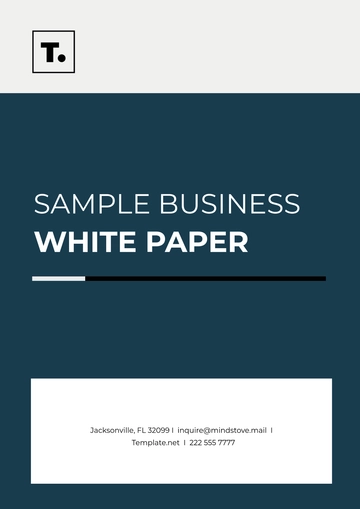Free Quantitative Format Research Paper

Prepared By: [Your Name]
I. Abstract
Write a concise summary of the research, including its purpose, methodology, key findings, and implications. Limit it to 150-250 words. Ensure the abstract is standalone and provides a clear overview of the paper.
Example:
This research paper delves into consumer behavior within the e-commerce landscape, employing quantitative research methodologies to identify and evaluate key factors influencing online shopping decisions. Data was collected through structured surveys targeting a diverse consumer base, with subsequent analysis performed using advanced statistical tools. The results offer a comprehensive understanding of e-commerce dynamics and present actionable insights for businesses seeking to enhance their digital strategies and improve customer satisfaction.
II. Introduction
Introduce the topic of e-commerce and its significance in the modern marketplace. Explain why understanding consumer behavior is crucial for e-commerce businesses. State the specific focus of your research and provide a brief overview of the factors being studied. Conclude with the research's purpose and importance.
Example:
The advent of e-commerce has fundamentally altered consumer purchasing patterns, offering unprecedented convenience, a vast selection of products, and 24/7 availability. In this digital marketplace, understanding the factors that drive consumer behavior is crucial for businesses aiming to succeed. This research seeks to quantify the impact of various determinants on online shopping behavior, providing a data-driven foundation for strategic decision-making in e-commerce. By focusing on factors such as convenience, trust, price sensitivity, and product variety, this study aims to illuminate the priorities and preferences of online consumers.
III. Research Objectives
Clearly define the goals of your research. List 2–4 specific, measurable objectives that guide your study. These should reflect the key aspects of consumer behavior you aim to understand or quantify.
Example:
To identify and rank the primary factors influencing consumer behavior in e-commerce settings.
To quantitatively assess the impact of these factors on online shopping decisions using robust statistical methods.
To generate actionable insights for e-commerce businesses, enabling them to enhance customer experience and foster loyalty.
IV. Literature Review
Summarize existing studies on consumer behavior in e-commerce. Highlight key factors identified in previous research, such as price sensitivity, trust, convenience, and product variety. Identify gaps in the literature that your study seeks to fill, such as the need for quantitative measurements of these factors.
Example:
Existing literature on consumer behavior in e-commerce identifies several critical factors that influence purchasing decisions. Price sensitivity has been widely recognized as a key determinant, with consumers often comparing prices across platforms before making a purchase. Trust in the e-commerce platform, including perceptions of security and privacy, is another significant factor. The variety of products available and the convenience of the shopping experience—encompassing aspects such as ease of navigation, payment options, and delivery speed—also play vital roles. However, despite these insights, there remains a gap in the literature concerning the precise quantification of these factors' impact on consumer behavior, which this study aims to address.
V. Methodology
Describe the research design and approach. Explain why you chose a quantitative method and outline the steps taken to gather and analyze data. Provide details about your target population, sampling method, and survey distribution channels.
Example:
This study employs a quantitative research approach, utilizing a cross-sectional survey design to gather data. The target population includes a diverse group of online shoppers, selected to ensure a wide representation of different demographics, including age, gender, income level, and geographic location. The survey was distributed online via email and social media platforms, ensuring broad reach and engagement.
VI. Survey Design
Detail how the survey was structured to collect relevant data. Mention the number of questions, types of questions (e.g., close-ended), and the use of scales like the Likert scale. Include information on how demographic data was collected to support meaningful segmentation.
Example:
The survey consisted of 20 close-ended questions, strategically designed to capture the nuances of online shopping behavior.
A 5-point Likert scale was used to measure the importance of various factors influencing consumer decisions, ranging from "Strongly Disagree" to "Strongly Agree."
Demographic questions were included to facilitate segmentation and ensure that the analysis could account for potential variations across different consumer groups.
VII. Data Collection
Explain the data collection process, including the duration, tools used, and response management. Address how responses were validated, cleaned, and prepared for analysis. Mention the total number of valid responses and how you ensured a diverse sample.
Example:
The survey was distributed over four weeks, garnering a total of 500 valid responses. Respondents were sourced from various social media platforms and email lists, ensuring a diverse sample representative of the broader online consumer base. The data was cleaned and prepared for analysis, with incomplete or inconsistent responses excluded to maintain the integrity of the results.
VIII. Data Analysis
Provide an overview of the statistical tools and techniques used. Explain how descriptive and inferential statistics were applied to interpret data. Mention specific analyses performed, such as correlation or regression, to assess relationships between factors.
Example:
The collected data was analyzed using statistical software, with both descriptive and inferential statistics applied to interpret the findings. Descriptive statistics, including mean scores and standard deviations, provided an overview of the central tendencies and variability within the data. Inferential statistics, such as correlation and regression analysis, were employed to explore the relationships between variables and to determine the relative impact of each factor on consumer behavior.
IX. Results
Present the findings clearly and concisely in both text and tabular formats. Include key statistics such as mean scores and standard deviations. Highlight the ranking of factors based on their significance and provide a brief interpretation of the results.
Example:
Factor | Mean Score | Standard Deviation |
|---|---|---|
Price Sensitivity | 4.2 | 0.8 |
Trust | 4.5 | 0.7 |
Product Variety | 4.0 | 0.9 |
Convenience | 4.7 | 0.6 |
The results indicate that convenience emerged as the most significant factor influencing consumer behavior in e-commerce, with a mean score of 4.7 and a relatively low standard deviation, suggesting strong agreement among respondents. Trust followed closely with a mean score of 4.5, underscoring its critical role in online shopping. Price sensitivity and product variety were also important but ranked slightly lower, with mean scores of 4.2 and 4.0, respectively.
X. Discussion
Discuss the implications of your findings about the research objectives and existing literature. Analyze the significance of each factor and suggest actionable recommendations for e-commerce businesses. Address any unexpected results and their potential explanations.
Example:
The findings from this study align with existing literature that underscores the importance of convenience and trust in e-commerce. However, this research adds a quantitative dimension, offering precise measurements of each factor's impact on consumer behavior. The high mean score for convenience suggests that e-commerce businesses should prioritize user-friendly interfaces, efficient checkout processes, and reliable delivery services to enhance customer satisfaction. The significance of trust highlights the need for robust security measures, transparent privacy policies, and consistent customer support.
While price sensitivity remains an important factor, its lower ranking relative to convenience and trust suggests that consumers may prioritize a seamless shopping experience and reliability over marginal price differences. Product variety also plays a crucial role, indicating that a broad selection of products can attract and retain customers, particularly in competitive markets.
XI. Conclusion
Summarize the research's key findings and their implications for e-commerce businesses. Reiterate the importance of convenience, trust, price sensitivity, and product variety. Provide recommendations for future research to explore unexplored aspects or refine the study.
Example:
This study provides valuable insights into the factors influencing consumer behavior in e-commerce, emphasizing the importance of convenience, trust, price sensitivity, and product variety. By quantifying these factors, the research offers a data-driven foundation for e-commerce businesses to refine their strategies. To remain competitive, businesses should focus on enhancing convenience and building trust while also offering competitive pricing and a diverse product range. These strategies are likely to result in improved customer satisfaction, increased loyalty, and sustained growth in the digital marketplace.
- 100% Customizable, free editor
- Access 1 Million+ Templates, photo’s & graphics
- Download or share as a template
- Click and replace photos, graphics, text, backgrounds
- Resize, crop, AI write & more
- Access advanced editor
Present your data-driven studies with precision using Template.net's Quantitative Research Paper Template. This editable and customizable template includes sections for hypothesis, methodology, data analysis, and results, providing a clear framework for your research. Editable in our AI Editor Tool, it ensures your quantitative research is meticulously organized, enhancing the clarity and impact of your findings.





























